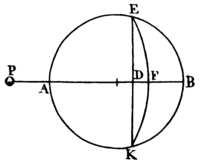and (by what Archimedes has demonſtrated) that ſuperficies will he as PF x DF x O. Let us ſuppoſe beſides the attractive forces of the particles of the ſphere to be reciprocally as that power of the diſtances, of which n is index; and the force with which the ſuperhcies EFG attracts the body P, will be (by prop. 79.) as, that is, as . Let the perpendicular FN, drawn into O be proportional to this quantity; and the curvilinear area BDI, which the ordinate FN, drawn through the length DB with a continued motion will deſcribe, will be as the whole force with which the whole ſegment RBSD attracts the body P. Q. E. I.
Proposition LXXXIV. Problem XLIII.
To find the force with which a corpuſcle, placed without the centre of a ſphere in the axis of any ſegment, is attracted, by that ſegment.

Let the body P placed in the axis ADB of the ſegment EBK (Pl. 23. Fig. 6.) be attracted by that ſegment. About the centre P with the interval PE let the ſphærical ſuperficies EFK be deſcribed; and let it divide the ſegment into two parts EBKFE and EFKDE. Find the force of the firſt of thoſe parts by prop. 81. and the force of the latter part by prop. 83. and the ſum of the forces will be the force Pf the whole ſegment EBKDE. Q. E. I.


